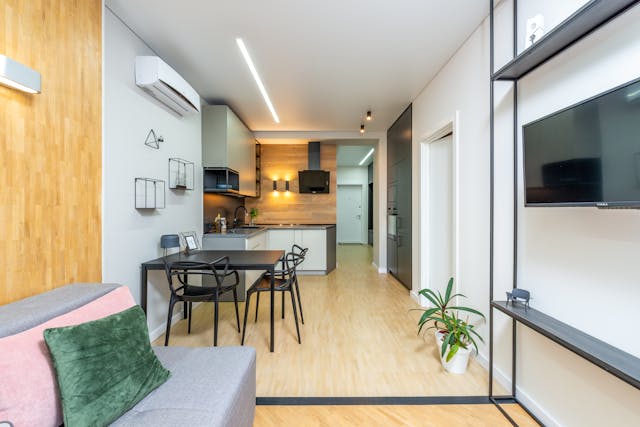- High indoor humidity can cause discomfort and health issues and damage your home’s structure and belongings.
- Use exhaust fans, air conditioners, and dehumidifiers to manage and reduce excessive moisture effectively.
- Regularly cleaning and maintaining your home’s ventilation systems ensures optimal humidity control and air quality.
- Monitor indoor humidity levels with a hygrometer to keep them between 30 and 50% for ideal comfort.
- Combining daily habits with strategic investments in moisture management tools enhances living spaces and overall well-being.
Maintaining a comfortable and safe living environment for you and your family is a top priority as a homeowner. However, one often overlooked aspect of home comfort is the level of humidity indoors. High humidity can lead to various problems, including health issues, reduced indoor air quality, and damage to your home’s structure and contents. You can better control this crucial aspect of home well-being with a comprehensive understanding of indoor humidity and available tools. This guide will take you through the essentials of managing indoor humidity effectively, ensuring a healthier, more comfortable living space for you and your family.
Understanding Humidity and Its Impacts
Humidity refers to the concentration of water vapor present in the air. This is commonly gauged as relative humidity, which is expressed as a percentage. It contrasts the existing absolute humidity with its highest possible level. Elevated levels of humidity indoors can lead to discomfort, and may severely impact both health and the structural integrity of homes.
Encouragement of Mold and Mildew Growth
Mold and mildew flourish in moist conditions. As humidity levels exceed 60%, these potentially dangerous fungi proliferate on walls, ceilings, and various surfaces, exacerbating respiratory problems and allergic responses within households.
Deterioration of Indoor Air Quality
Excess moisture can also lead to a decline in indoor air quality. Dust mites, another common allergen, proliferate in humid conditions and can exacerbate allergies and asthma.
Damage to Furniture, Electronics, and Building Materials
Moisture in the air can cause wood to swell and doors to stick. Over time, high humidity can lead to the deterioration of electronics, peeling paint, and even structural damage in the form of rot.
Practical Steps to Manage Indoor Humidity
Controlling indoor humidity can seem daunting, but homeowners can employ several practical strategies to maintain a healthy balance.
Ventilation Strategies
Effective ventilation is crucial in moisture-prone areas such as the kitchen, bathroom, and laundry. Natural ventilation, like opening windows and doors, can be enhanced by using exhaust fans to remove humid air from these spaces.

Using Dehumidifiers
Dehumidifiers are essential appliances for homes in humid climates. These devices draw in moist air and condense the water vapor, releasing dry air into the environment. They should be placed in areas with the highest humidity levels, such as basements and crawl spaces.
Maintaining Optimal Air Flow
Good air circulation can help prevent moisture from settling in one place. Ceiling and standing fans are:
- Excellent tools for moving air.
- Inhibiting mold growth.
- Maintaining a more consistent overall humidity level.
Incorporating Moisture-Resistant Building Materials
When renovating or performing repairs in moisture-prone areas, consider using building materials resistant to water damage. This can include moisture-resistant bathroom wallboards and properly treated lumber in outdoor construction.
Leveraging Your HVAC System to Control Humidity
Your heating, ventilating, and air conditioning (HVAC) system significantly manages indoor humidity, especially during the warmer months.
Understanding the Role of Air Conditioning in Humidity Control
Air conditioners not only cool the air but also dehumidify it. When warm air passes over the cooling coils, the moisture condenses, leaving cooler, drier air circulating throughout your home. While air conditioners are effective dehumidifiers, they can also overcool the air, so finding the right balance is key. Ensuring proper air conditioning tune up is crucial in maintaining your HVAC’s efficiency and humidity control capabilities.

Critical Importance of Regular HVAC Maintenance
Scheduling routine maintenance is crucial to ensure your HVAC system is running efficiently. This service should include checking refrigerant levels, cleaning coils, and inspecting condensate drains to prevent blockages. You can trust your HVAC system to manage indoor humidity effectively by keeping it in top condition.
Utilizing Dehumidifiers for Added Humidity Control
In addition to leveraging your HVAC system, incorporating dehumidifiers into your home can provide an extra layer of control over humidity levels. These devices are particularly useful in areas that are naturally damp or have little ventilation, such as basements, bathrooms, and kitchens. Dehumidifiers extract water from the air, reducing mold and mildew development opportunities. For optimal effectiveness, consider the size and capacity of the dehumidifier for the space you’re aiming to dehumidify. Remember to regularly empty and clean the water reservoir to prevent bacterial growth.
Monitoring Humidity Levels to Safeguard Your Environment
Keeping a close eye on the humidity levels within your home is essential for maintaining a comfortable and healthy indoor environment. Hygrometers, devices designed to measure the moisture content in the air, can be a valuable tool in this regard. You can decide when to activate dehumidifiers, air conditioners, or other moisture management strategies by monitoring these levels. Maintaining indoor humidity levels between 30-50% can help balance comfort and air quality.
Conclusion
Maintaining the proper humidity levels within your home is a multifaceted task that requires both awareness and action. By recognizing the signs of high humidity and employing the strategies outlined in this guide, you can create a living space that is more comfortable, healthier, and more durable. From everyday habits like using exhaust fans to more significant investments in dehumidifiers and home materials, every step to reduce indoor humidity is a step towards a better quality of life.

